engine TOYOTA 86 2019 Owner's Guide
[x] Cancel search | Manufacturer: TOYOTA, Model Year: 2019, Model line: 86, Model: TOYOTA 86 2019Pages: 532, PDF Size: 6.89 MB
Page 129 of 532
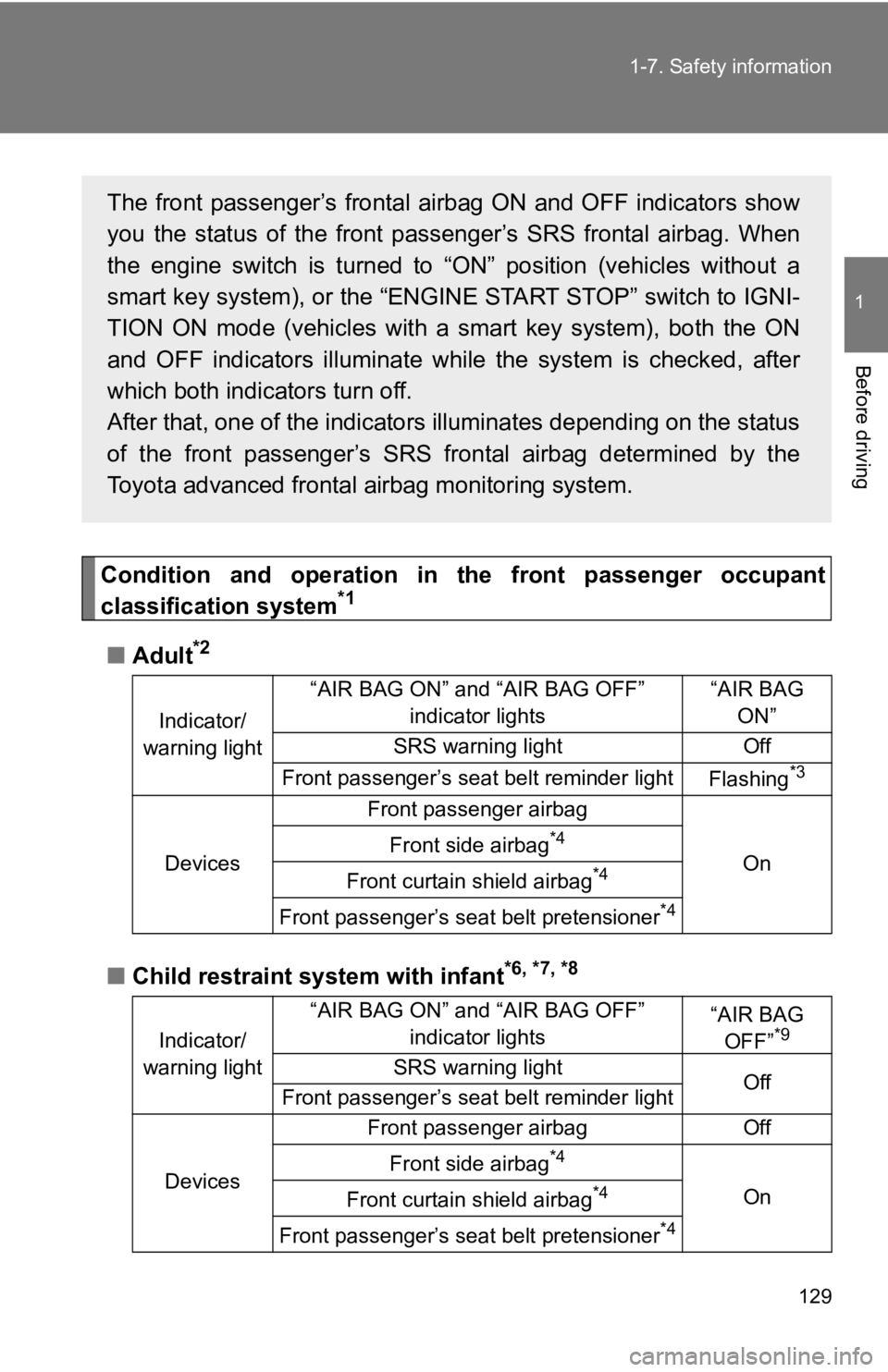
1291-7. Safety information
1
Before driving
Condition and operation in t he front passenger occupant
classification system *1
■ Adult *2
■ Child restraint system with infant *6, *7, *8Indicator/
warning light “AIR BAG ON” and “AIR BAG OFF”
indicator lights “AIR BAG
ON”
SRS warning light Off
Front passenger’s seat belt reminder light
Flashing *3
Devices Front passenger airbag
OnFront side airbag *4
Front curtain shield airbag *4
Front passenger’s seat belt pretensioner *4
Indicator/
warning light “AIR BAG ON” and “AIR BAG OFF”
indicator lights “AIR BAG
OFF” *9
SRS warning light
Off
Front passenger’s seat belt reminder light
Devices Front passenger airbag Off
Front side airbag *4
On
Front curtain shield airbag *4
Front passenger’s seat belt pretensioner *4The front passenger’s frontal airbag ON and OFF indicators show
you the status of the front pass enger’s SRS frontal airbag. Whe n
the engine switch is turned to “ ON” position (vehicles without a
smart key system), or the “ENGINE START STOP” switch to IGNI-
TION ON mode (vehicles with a smart key system), both the ON
and OFF indicators illuminate whil e the system is checked, afte r
which both indicators turn off.
After that, one of the indicators illuminates depending on the status
of the front passenger’s SRS frontal airbag determined by the
Toyota advanced frontal airbag monitoring system.
Page 132 of 532

1321-7. Safety information
If the passenger’s frontal airbag OFF indicator illuminates and the ON indicator
turns off even when the front passenger’s seat is occupied by a n adult
This can be caused by an adult incorrectly sitting in the front passen-
ger’s seat. Perform the following.
Vehicles without a smart key system:
The engine switch is turned to the “LOCK” position.
Vehicles with a smart key system:
Turn the “ENGINE START STOP” switch off.
Ask the front passenger to set the seatback to the upright
position, sit up straight in the center of the seat cushion, co r-
rectly wear the seat belt, position his/her legs out forward, a nd
adjust the seat to the rearmost position.
Vehicles without a smart key system:
The engine switch is tur ned to the “ON” position.
Vehicles with a smart key system:
Turn the “ENGINE START STOP” switch to IGNITION ON
mode.
If the OFF indicator remains illuminated while the ON indicator
remains off, perform the following.
• Vehicles without a smart key system:
The engine switch is turned to the “LOCK” position.
Vehicles with a smart key system:
Turn the “ENGINE START STOP” switch off.
• Make sure that the front passenger is not using a blanket,
seat cushion, seat cove r or seat heater, etc.
• If wearing excessive layers o f clothing, the front passenger
should remove any unnecessary items before sitting in the
front passenger seat, or s hould sit in a rear seat.STEP 1
STEP 2
STEP 3
STEP 4
Page 133 of 532

1331-7. Safety information
1
Before driving The engine switch is turned to the “ON” position (vehicles
without a smart key system), or the “ENGINE START STOP”
switch to IGNITION ON mode (vehicles with a smart key sys-
tem). After the self-check is performed, the ON indicator
should illuminate while the OFF indicator remains off. If the
OFF indicator still remains illumi nated while the ON indicator
remains off, ask the occupant to move to the rear seat and
immediately contact your Toyo ta dealer for an inspection.STEP 5
Page 134 of 532

1341-7. Safety information
If the front passenger’s frontal airbag ON indicator illuminate s and the OFF indicator turns off
even when an infant or a small child is in a child restraint system (including booster seat)
This can be caused by the child restraint system being installe d incor-
rectly. Perform the following.
Vehicles without a smart key system:
The engine switch is turned to the “LOCK” position.
Vehicles with a smart key system:
Turn the “ENGINE START STOP” switch off.
Remove the child restraint system from the seat. By referring
to the child restraint manufacturer’s recommendations as well
as the child restraint system in stallation procedure in “child
restraint system”, correctly rein stall the child restraint syst em.
Vehicles without a smart key system:
The engine switch is turned to the “ON” position and make
sure that the front passenger’s frontal airbag ON indicator
turns off and the OFF indicator illuminates.
Vehicles with a smart key system:
Turn the “ENGINE START STOP” switch to IGNITION ON
mode and make sure that the front passenger’s frontal airbag
ON indicator turns off and t he OFF indicator illuminates.
If the ON indicator still remains illuminated while the OFF ind i-
cator turns off, perform the following.
• Ensure that no article is pla ced on the seat other than the
child restraint system and the child occupant.
• Ensure that the backward-fo rward position and seatback of
front passenger seat are locked into place securely by mov-
ing the seat back and forth.
If the ON indicator still remains illuminated while the OFF ind i-
cator turns off after taking the relevant corrective actions
described above, relocate the child restraint system to the
rear seat and immediately contact your Toyota dealer for an
inspection.STEP 1
STEP 2
STEP 3
STEP 4
STEP 5
Page 151 of 532
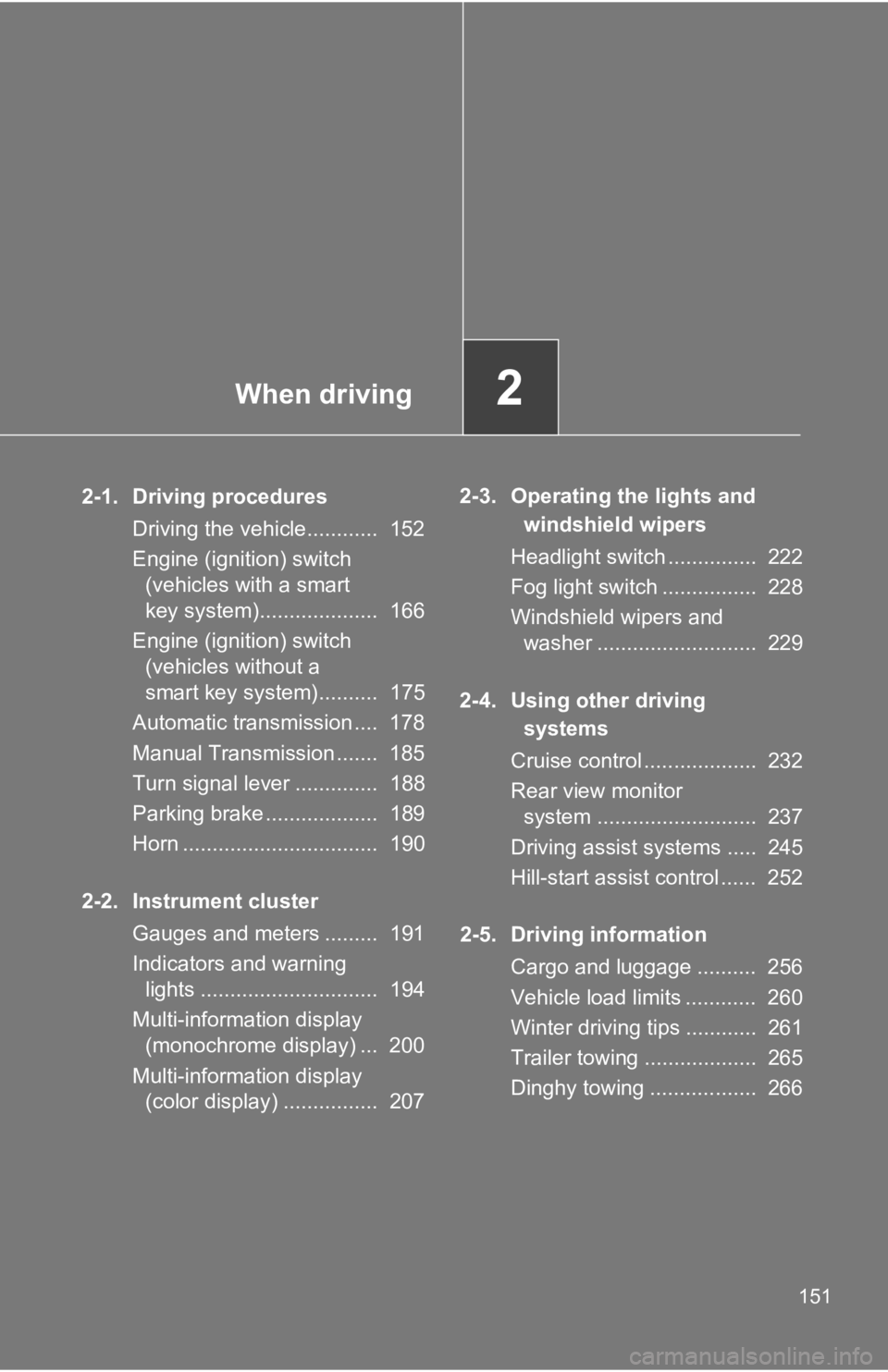
When driving
2
1512-1. Driving procedures
Driving the vehicle............ 152
Engine (ignition) switch
(vehicles with a smart
key system).................... 166
Engine (ignition) switch
(vehicles without a
smart key system).......... 175
Automatic transmission .... 178
Manual Transmission ....... 185
Turn signal lever .............. 188
Parking brake ................... 189
Horn ................................. 190
2-2. Instrument cluster
Gauges and meters ......... 191
Indicators and warning
lights .............................. 194
Multi-information display
(monochrome display) ... 200
Multi-information display
(color display) ................ 207 2-3. Operating the lights and
windshield wipers
Headlight switch ............... 222
Fog light switch ................ 228
Windshield wipers and
washer ........................... 229
2-4. Using other driving
systems
Cruise control ................... 232
Rear view monitor
system ........................... 237
Driving assist systems ..... 245
Hill-start assist control ...... 252
2-5. Driving information
Cargo and luggage .......... 256
Vehicle load limits ............ 260
Winter driving tips ............ 261
Trailer towing ................... 265
Dinghy towing .................. 266
Page 152 of 532
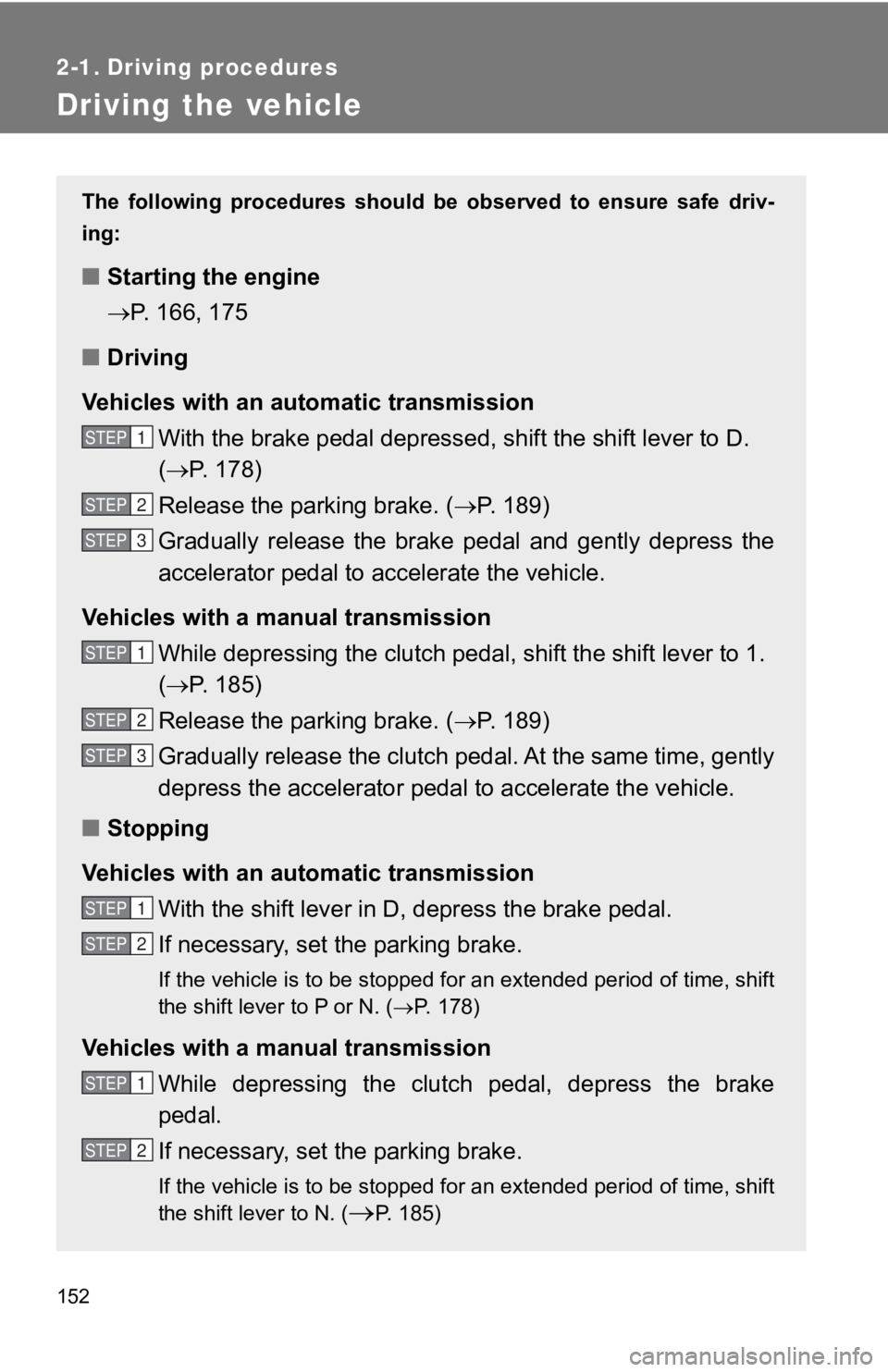
1522-1. Driving procedures
Driving the vehicle The following procedures should be observed to ensure safe driv -
ing:
■ Starting the engine
P. 166, 175
■ Driving
Vehicles with an auto matic transmission
With the brake pedal depressed, shift the shift lever to D.
( P. 1 7 8 )
Release the parking brake. ( P. 189)
Gradually release the brake pedal and gently depress the
accelerator pedal to accelerate the vehicle.
Vehicles with a manual transmission
While depressing the clutch pedal , shift the shift lever to 1.
( P. 1 8 5 )
Release the parking brake. ( P. 189)
Gradually release the clutch pedal. At the same time, gently
depress the accelerator pedal to accelerate the vehicle.
■ Stopping
Vehicles with an auto matic transmission
With the shift lever in D, depress the brake pedal.
If necessary, set the parking brake. If the vehicle is to be stopped for an extended period of time, shift
the shift lever to P or N. ( P. 178)
Vehicles with a manual transmission
While depressing the clutch pedal, depress the brake
pedal.
If necessary, set the parking brake.
If the vehicle is to be stopped for an extended period of time, shift
the shift lever to N. (
P. 185) STEP 1
STEP 2
STEP 3
STEP 1
STEP 2
STEP 3
STEP 1
STEP 2
STEP 1
STEP 2
Page 153 of 532
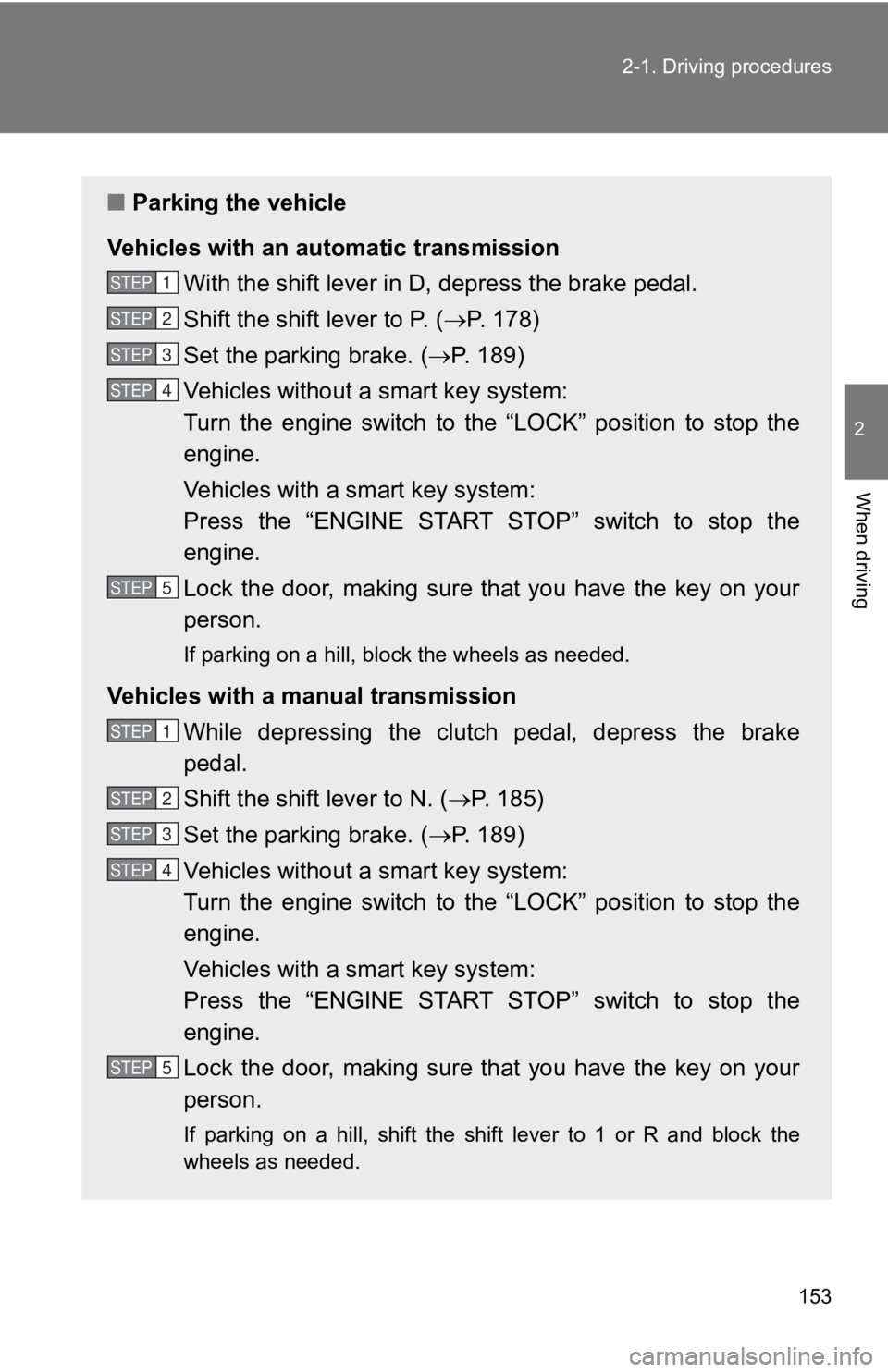
1532-1. Driving procedures
2
When driving ■ Parking the vehicle
Vehicles with an auto matic transmission
With the shift lever in D, depress the brake pedal.
Shift the shift lever to P. ( P. 1 7 8 )
Set the parking brake. ( P. 1 8 9 )
Vehicles without a smart key system:
Turn the engine switch to the “LOCK” position to stop the
engine.
Vehicles with a smart key system:
Press the “ENGINE START STOP” switch to stop the
engine.
Lock the door, making sure that you have the key on your
person. If parking on a hill, block the wheels as needed.
Vehicles with a manual transmission
While depressing the clutch pedal, depress the brake
pedal.
Shift the shift lever to N. ( P. 185)
Set the parking brake. ( P. 1 8 9 )
Vehicles without a smart key system:
Turn the engine switch to the “LOCK” position to stop the
engine.
Vehicles with a smart key system:
Press the “ENGINE START STOP” switch to stop the
engine.
Lock the door, making sure that you have the key on your
person.
If parking on a hill, shift the shift lever to 1 or R and block the
wheels as needed.STEP 1
STEP 2
STEP 3
STEP 4
STEP 5
STEP 1
STEP 2
STEP 3
STEP 4
STEP 5
Page 155 of 532

1552-1. Driving procedures
2
When driving ■ Engine speed while driving (vehicles with an automatic transmis sion)
In the following conditions, the engine speed may become high w hile driving.
This is due to automatic up-shifting control or down-shifting i mplementation
to meet driving conditions. It does not indicate sudden acceleration.
● The vehicle is judged to be driving uphill or downhill
● When the accelerator pedal is released
● When driving on curves
● When the brake pedal is firmly depressed
■ New vehicle break-in driving (the first 1000 miles [1600 km])
The performance and long life of your vehicle are dependent on how you
handle and care for your vehicle while it is new. Follow these instructions
during the first 1000 miles (1600 km):
● Do not allow the engine speed to exceed 4000 rpm except in an e mer-
gency.
● Do not drive at one constant engine or vehicle speed for a long time,
either fast or slow.
● Avoid starting suddenly and rapid acceleration, except in an em ergency.
● Avoid hard braking, except in an emergency.
The same break-in procedures should be applied to an overhauled
engine, newly mounted engine or when brake pads or brake lining s are
replaced with new ones.
■ High friction brake pads (if equipped)
The brake pads and discs are designed for use under high load c onditions.
Therefore, brake noise may be generated depending on the vehicl e speed,
braking force and vehicle environment (temperature, humidity, e tc.).
■ Drum-in-disc type parking brake system
Your vehicle has a drum-in-disc type parking brake system. This type of
brake system needs bedding-down of the brake shoes periodically or when-
ever the parking brake shoes and/or drum are replaced. Have you r Toyota
dealer perform the bedding down.
Page 156 of 532
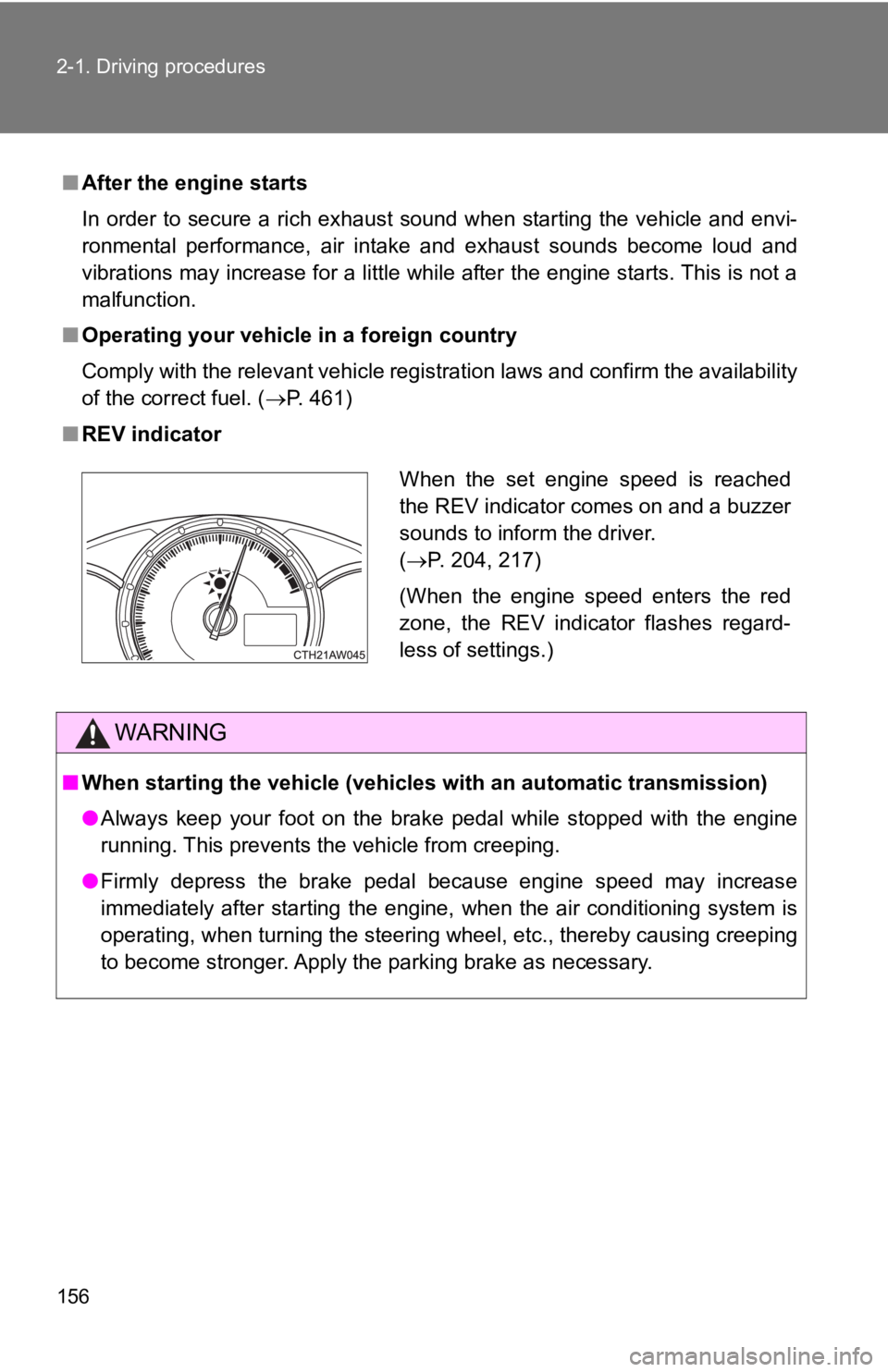
1562-1. Driving procedures
■ After the engine starts
In order to secure a rich exhaust sound when starting the vehicle and envi-
ronmental performance, air intake and exhaust sounds become lou d and
vibrations may increase for a little while after the engine starts. This is not a
malfunction.
■ Operating your vehicle in a foreign country
Comply with the relevant vehicle registration laws and confirm the availability
of the correct fuel. ( P. 461)
■ REV indicator
WARNING■ When starting the vehicle (vehicl es with an automatic transmission)
● Always keep your foot on the brake pedal while stopped with the engine
running. This prevents the vehicle from creeping.
● Firmly depress the brake pedal because engine speed may increas e
immediately after starting the engine, when the air conditionin g system is
operating, when turning the steering wheel, etc., thereby causi ng creeping
to become stronger. Apply the parking brake as necessary. When the set engine speed is reached
the REV indicator comes on and a buzzer
sounds to inform the driver.
( P. 204, 217)
(When the engine speed enters the red
zone, the REV indicator flashes regard-
less of settings.)
Page 157 of 532

1572-1. Driving procedures
2
When driving WARNING■ When driving the vehicle
● Do not drive if you are unfamiliar with the location of the brake and accel-
erator pedals to avoid depressing the wrong pedal.
• Accidentally depressing the accelerator pedal instead of the b rake
pedal will result in sudden acceleration that may lead to an accident
that could result in death or serious injury.
• When backing up, you may twist your body around, leading to a diffi-
culty in operating the pedals. Make sure to operate the pedals properly.
• Make sure to keep a correct driving posture even when moving t he
vehicle only slightly. This allows you to depress the brake and acceler-
ator pedals properly.
• Depress the brake pedal using your right foot. Depressing the brake
pedal using your left foot may delay response in an emergency, result-
ing in an accident.
● Do not drive the vehicle over or stop the vehicle near flammabl e materials.
The exhaust system and exhaust gases can be extremely hot. Thes e hot
parts may cause a fire if there is any flammable material nearb y.
● On vehicles with an automatic transmission, do not let the vehi cle roll
backward while the shift lever is in a driving position, or roll forward while
the shift lever is in R.
Doing so may cause the engine to stall or lead to poor brake an d steering
performance, resulting in an accident or damage to the vehicle.
● If the smell of exhaust is noticed inside the vehicle, open the windows and
check that the trunk is closed. Large amounts of exhaust in the vehicle can
cause driver drowsiness and an accident, resulting in death or a serious
health hazard. Have the vehicle inspected by your Toyota dealer immedi-
ately.
● On vehicles with a manual transmission, do not shift the shift lever to R
while the vehicle is moving forward.
Doing so can damage the transmission and may result in a loss o f vehicle
control.
● Do not shift the shift lever to a driving position while the ve hicle is moving
backward.
Doing so can damage the transmission and may result in a loss o f vehicle
control.